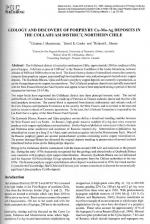Добрый день, Коллеги. Важное сообщение, просьба принять участие. Музей Ферсмана ищет помощь для реставрационных работ в помещении. Подробности по ссылке
Geology and Discovery of Porphyry Cu-Mo-Ag Deposits in the Collahuasi District, Northern Chile
The Collahuasi district is located in northeastern Chile, approximately 200 km southeast of the port of Iquique. It defines an area of 1200 km2 in the Western Cordillera of the Andes Mountains, between altitudes of 4000 and 5000 m above sea level. The district hosts a cluster of mineralised centres that currently comprise three porphyry copper, associated high level epithermal vein, and palaeogravel-hosted exotic copper deposits. The Quebrada Blanca, Ujina and Rosario porphyry copper deposits are currently in production, as are the Huinquintipa exotic copper accumulations. The Collahuasi porphyry deposits are spatially associated with the West Fissure/Domeyko Fault System and appear to have been emplaced during a period of dextral transpression between 35-34 Ma.
Two major faults have segmented the Collahuasi district into three principal tectonic units. The central uplifted block of Collahuasi Formation is made up of Permian to Triassic andesite, dacite and rhyolite with small porphyry intrusions. The central block is separated from Jurassic sedimentary and volcanic rocks of the Cerro Empexa and Quehuita Formations to the west by the West Fissure, and is overlain to the east and north by extensive sheets of Cenozoic ignimbrites. To the east, the Collahuasi Fonnation is truncated by the Loa Fault that is a splay of the West Fissure Fault System.
The Quebrada Blanca, Rosario and Ujina porphyry centres define a broad east-trending corridor between the West Fissure and Loa Faults. At Rosario, high-grade massive sulphide (Cu-Ag-Au) veins overprint porphyry-style copper-molybdenum mineralisation. Similar high-sulphidation veins occur in the La Grande and Poderosa areas southwest and southeast of Rosario respectively. Intermediate-sulphidation Ag mineralisation occurs in a long (3 to 5 km), semi continuous quartz vein in the Monctezuma Fault. West of the Rosario porphyry centre are several palaeochannel systems containing exotic copper mineralisation. The present drainage system has dissected the original deposit resulting in preservation of several isolated mineralised bodies know as the Huinquintipa deposits.
Mining in the Collahuasi district commenced with the Incas around 1400 A.D. and continues to the present day. During the early 1970s Anacaonda recognised that the geology and altered rocks at Quebrada Blanca were consistent with porphyry-style copper mineralisation. However, Quebrada Blanca was not delineated until the Superior Oil/Falconbridge Group optioned the property from the Chilean authorities in the late 1970s. The Rosario porphyry- copper-molybdenum-silver deposit was discovered in 1979, but it took another 12 years for the Falconbridge, Shell Chile and Chevron joint venture consortium to discover the economically significant Ujina porphyry Cu-Mo deposit.




